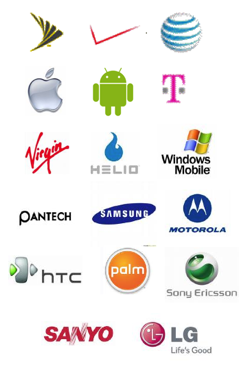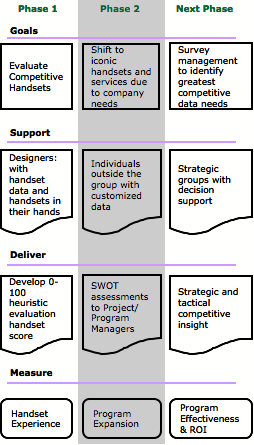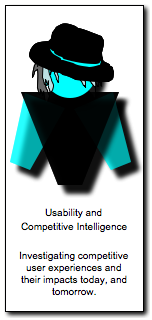Overview
The Competitive User Experience Program was established in order to inform and support the User Experience Design team in their efforts to produce superior user experiences on the handsets. The iPhone was no longer a rumor, and many, from designers to executives, wanted to know if the advertised iPhone was truly as great as it promised to be. Additionally, given that the iPhone was not an apples to apples comparison (pun intended) for most of the other handsets coming to market, the program was also geared towards measuring the user experience of any telecom handset. While the program got its real start with the iPhone, many groups would solicit assistance on a wide variety of topics. The Competitive User Experience Program growth chart below at right demonstrates the growth of the program over its initial two (plus) years.
The success of the program could be seen from its impact upon design and decision making. Operationally defining and measuring the specific impact was planned into the next phase of the program. Success of the program came mostly through the dissemination of competitive information to an extensive number of teams, but also through my personal growth as I worked to develop a greater sense of urgency in delivering results. The program, after all, had to be as proactive as possible, and most often information was requested "just in time," which meant I needed my information "yesterday."
Program Design
A strategic map was created in order to get the program moving towards its initial goals. The following timeline provides an understanding of the progress gained over its two year period.
2007
- Create a method of evaluating handsets.
- Identify over 400 tasks that could be used to evaluate the handsets.
- Evaluate an initial set of handsets to further refine the evaluation method and begin producing benchmark competitive handset scores.
- Support evaluation of other competitive services and user interfaces as needed.
2008 - 1st Half
- Reduce the number of tasks evaluated to about 50 tasks in order to create a representative sample an expedite evaluations.
- Continue to conduct handset reviews
- Conduct service, web, and other competitive reviews
- Expand functional group support by allowing for incoming requests and by advertising the program.
- Design a competitive web site available to everyone at Sprint and provide continuous updates
2008 - 2nd Half
- Refocus activities to primarily support service, web, and other requests due to the dramatic increase in external group support requests.
- Continue handset reviews
- Continue to expand functional group support
2009 Jan - Feb
- Continue to conduct service, web, and handset reviews, and to expand functional group support.
- Begin to investigate a method of measuring the impact of the program
- Automate checkout/return of competitive handsets by implementing a process already being used for internal Sprint handsets
Accomplishments
The initial goal of the program was again to infuse competitive usability information into the Design and Research roles. This objective was achieved, and the program grew to fill many other needs. Here are a few:
- Provide advance notice of potential upcoming competitive user experiences to many groups
- Allow teams to live the competitive experience by putting the phones in their hands
- Supporting mission critical objectives within Legal that had user experiences as part of their root issues
- Provided awareness of competitive user experiences across many touch points. While this included the wireless phones, it also included customer service (phone and retail), wired web, bills, and communications
- Served as a member of strategic task forces to supply competitive information, increase awareness of Sprint advantages, and facilitate discussions concerning new or existing user experiences
Building on That
To build on the program, the next step was to increase the impact on strategic decisions and measure the program's success in more concrete terms. The Strategic Vision chart provides an overview of how the first two phases of the program were conducted, and how the next phase was to be executed.
Skills
- Program design and execution
- Leadership and persuasion, while able to take direction
- Strategic vision and tactical execution
- Delivering useful and timely results
- Team player as well as independent worker
- Work prioritization in a constantly changing environment
- Willingness to accept a challenge, and to grow personally along the way
Back to Portfolio Highlights
|
|

Strategic Vision

Competitive User Experience Program Growth: 2007-2009
|

